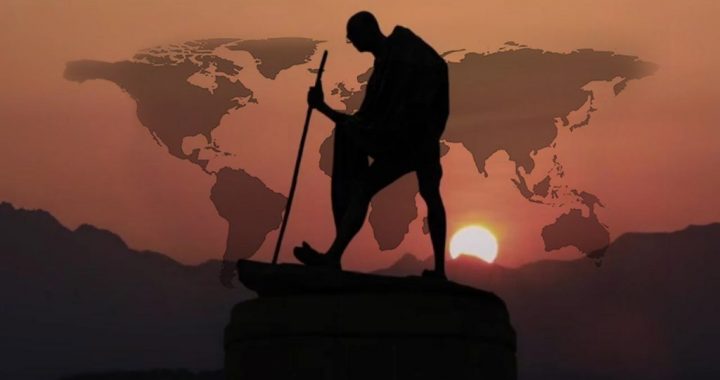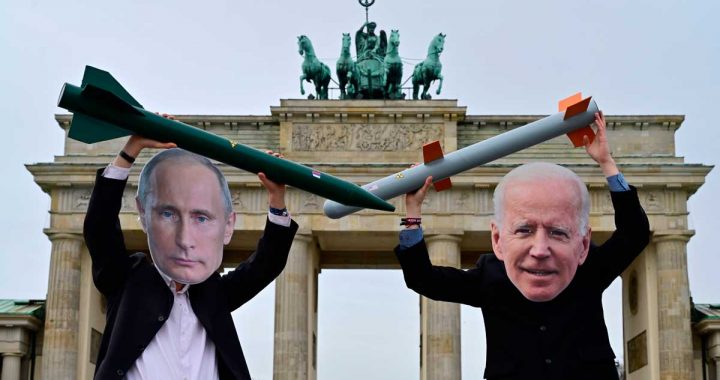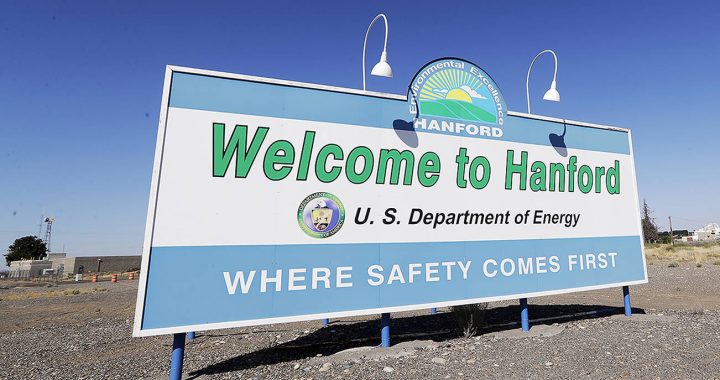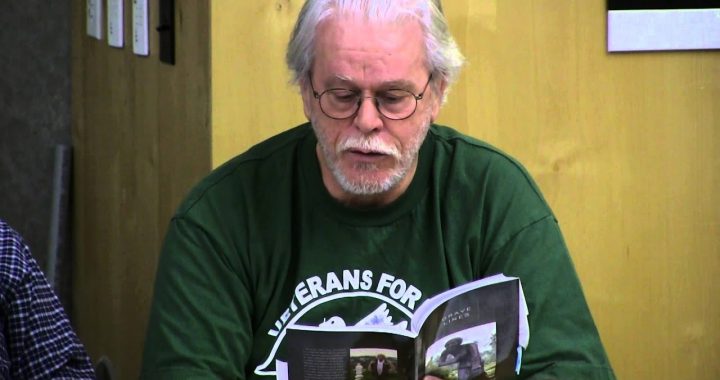Editor’s Note: Sometimes it really does take a “rocket scientist!” Many years ago Bob Aldridge was working at what is now Lockheed Martin working on a new missile for the OHIO Class “Trident” ballistic missile submarines. When he realized that he was designing more than a “defensive” weapon, and that the missile was being designed to be used as a first-strike weapon, he quit his job and ultimately helped form a community of nonviolent resistance that grew into the Pacific Life Community and Ground Zero Center for Nonviolent Action. Bob wrote many inspiring works along the way, and his book “The Goodness Field” represents the culmination of his journey of discovery in nonviolence. Bob recently joined the Cloud of Witnesses, and this book review, by Ground Zero co-founder Jim Douglass, provides a wonderful introduction to Bob’s final work. May The Goodness Field inspire us to help build the global consciousness (of which Bob writes) to bring about Global Satyagraha. Below is an excerpt from a letter from Bob to Glen Milner (in italics), followed by the forward to The Goodness Field written by Jim Douglass.
**********************
The Goodness Field, Reviewed by Jim Douglass
“Our daughter, Mary, is sheltering- in-place with us during this crisis. At our age it is a comfort to have a well- experienced nurse to help us. Mary and I are working together to take advantage of these horrible times as a trigger event for greater global consciousness leading to Global Satyagraha. Hidden in the quiet of the COVID-19 pandemic is a current of the collective consciousness that crosses political boundaries, and widens the focus of human connection. Ironically, within social distancing comes the benefit of reconnecting with ourselves and each other simply by slowing down. As the world comes to a halt in normal activity and isolation abounds, the US government seizes the opportunity (trigger event) to enact policies that are likely to be the new status quo. However, the same trigger event allows for a response of contagious nonviolence (K. Butigen) to reshape the priorities of our planet. Given the current social isolation, the technological talents of the younger generations can redirect the protectory of government policy through in- novative social connectivity and action. The Goodness Field – A Guidebook for Proactive Nonviolence engages nonviolent warriors in a global constructive program through the lens of historic pitfalls and successes and the required measured actions moving forward. Consequently, I have halted physical distribution of The Goodness Field and am making it available digitally. It is available to be circulated widely and posted on websites. Let us all make the most of this opportunity.”
Bob Aldridge has the knack of paying attention to an urge to do the right thing whenever he feels it. Then he does it — to the discomfort of those who know how the force of his example can change lives. In the almost half- century I’ve known Bob, the trails this nuclear weapons engineer turned peacemaker has blazed, following the whispers of his still small voice, have kept on redirecting my life. Be wary of reading The Goodness Field, if you are not open to meeting a man who could inspire you to climb mountains.
Feeling such an urge when he began the tenth decade of his life, Bob Aldridge researched thoroughly and wrote what he first described as “A Guidebook for Proactive Nonviolence.” What he saw brilliantly through that process, he identified in his final title as “The Goodness Field.” 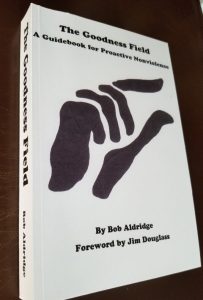
In August 1972, my wife Shelley and I met Bob and Janet Aldridge when they came from their home in Santa Clara, California, to Honolulu, Hawaii, to support our Catholic Action of Hawaii community in a trial. Three of us were liable to ten years each in prison for doing an act of moral and legal necessity by obeying a greater law. We had poured our blood on top-secret elec- tronic warfare files at Hickam Air Base, Pacific Air Force Headquarters — exposing Hickam, as Bob writes in this book’s last chapter, “as the intelligence and targeting center for the Vietnam air war.”
In a scene Shelley and I have recalled often from that intense week, we watched Bob sitting at a microphone on a stage in a theater at the University of Hawaii. He was flanked by two Nuremberg War Crimes Tribunal attorneys, who were assisting us in the trial. They had explained to the audience why our disruption of the electronic warfare office was a legal resistance, if not obligation, to a crime against peace.
When it came time for Bob to speak, as peace representative of the National Catholic Lay Association, he pushed the mic away and remained silent. He was responding to an urge. Shelley and I were unaware of Bob’s occupation as a nuclear missile designer, which he had begun to question. The Nuremberg lawyers’ presentations intensified the questioning. It provoked in Bob a pregnant silence. Taken up by the trial, we simply thought Bob a very shy man.
Two years later, following my resignation from the University of Hawaii faculty, Bob visited us at our house in the little town of Hedley, British Columbia, Canada. He told us of his resignation from his Lockheed job designing a nuclear first-strike weapon, the Trident missile system. Spreading out a map on our kitchen table, he pointed out the chosen site for the first Trident submarine base, on a peninsula across from Seattle, not so far from Hedley.
Bob’s visit became our invitation to co-found Pacific Life Community, which initiated a Gandhian campaign in resistance to Trident, prompting our move into the last house beside the railroad tracks going into the base. Ground Zero Center for Nonviolent Action, whose site bordered another part of the Trident base fence a mile away, was founded in 1977. The Trident campaign led in 1981 to the tracks campaign to stop Trident weapons shipments to its bases on both the Pacific and the Atlantic. That resulted in our further move in 1989 to another tracks house, along the trains’ southeastern route, in Birmingham, Alabama.
If ever a satyagrahi, a Gandhian practitioner of truth-force, has redirected Shelley’s and my lives, it has been Bob Aldridge through the quiet talk he walks, along with Janet, their children, grandchildren, and great grandchildren, who are a nonviolent wave all their own. We have learned with many others how to walk from the example of Bob, Janet, and their family — all the way from their decision that Bob resign at age 49 from Lockheed (now merged with Marietta as the #1 military industrial contractor), sparking the Trident campaign; through Bob’s groundbreaking books on our near extinction from the Pentagon’s nuclear first strike strategy spearheaded by Trident; to this pioneering work on our nonviolent transformation, The Goodness Field. I’ve had the gift, with others he asked to critique his manuscript, of seeing his nonviolence guidebook evolve into its present form. Bob has been mining everyone and everything he could for this work, re-climbing the mountain of his life, seeking a way to enlighten the night. He succeeds. Bob Aldridge’s relentless persistence has broken through finally, at the peak of his life and work, into the fundamental forcefield in the universe, the source of our necessary enlightenment through proactive nonviolence — goodness.
The goodness field, as Bob explains in an intriguing introduction and astounding appendix, is the pervasive force field of not only Earth but the entire universe. Goodness is the singular force needed to modulate the four fundamental forces of nature to support life. As egothink, a term Bob coined via Sigmund Freud and George Orwell. Yet we can still awaken to a volcanic energy in our collective unconscious, formed from the beginning of time. We can discern at the current crux of history a power erupting from the depths of our origin, if we only remove its obstacles through proactive nonviolence. Goodness is the transformative force of human existence. Goodness can be our cosmic companion, as we walk the Earth and talk the truth. Goodness is in the stardust empowering our every action concentrated nonvio- lently on the dark matter of this world, down to the jail cell of my own ego. Goodness is here, as we awaken, walk the Earth, and speak the truth of a universal force that has brought us this far so far. Goodness is the truth in proactive nonviolence that will set us free. Seed a Gandhian constructive program in the goodness field of this Earth, and it will grow.
Our crucial task in letting goodness work, Bob suggests with Gandhi, is taking on experiments with truth as near as our fingertips, pushing away obstacles to good- ness. Washing our dishes to wash the dishes, in Nhat Hanh’s image of mindful practice, will free us to be where we need to be, catching a wave of proactive nonviolence just in time. Converging drops of goodness and courage, becoming an ocean of waves of nonviolent movements, will prevail. Ours is the goodness story told all the way from its origin in the creative urge behind the Big Bang of the universe.
Maybe it does take a rocket scientist turned satyagrahi to see humanity’s redemptive truth of goodness. Is that Gandhi grinning through his microscope?
“Truth,” as Mohandas Gandhi said from his experiments with truth, “is God.” Or as Bob Aldridge has put it in a further step through his experiments, “Truth is goodness.” The ultimate truth of goodness, it turns out, is confirmed by the story of the universe. Our humanity’s radical goodness is seen, step by step, through our experience, in the discoveries of proactive nonviolence. We learn to walk truly in the dust of a million galaxies of goodness. Test and see.
An empire began to give way when a little man, with 78 committed friends from his ashram, marched to the sea to pick up a grain of salt. Our way into nonviolent transformation may be no more than our willingness to say yes to an urge of goodness at inconvenient moments in our lives, leading us to ashram disciplines and nonviolence training in the fire of goodness that can nurture a new way of life. Turn, turn, turn. Faith in goodness, acting through newly forged lives in a nonviolent community, is hope for our world.
Bob Aldridge is a nonviolent warrior for our time. The Goodness Field: A Guidebook for Proactive Nonviolence is the testament of his life. Its practical, nonviolent truths are carved out, hammer to chisel, with the help of Gandhi, King, and their disciplined disciples; the Standing Rock Sioux and the new paradigm of Sarvodaya via Wopida; a host of young people standing on their own feet, encircling the globe in resistance to gun violence and climate change; Bob and Janet Aldridge with their children, grandchildren, and great-great grands walking the way of proactive nonviolence before us.
We know we dwell in a time of deepening darkness. We are at two minutes to midnight—the nearest the Bulletin of Atomic Scientists Doomsday Clock has ever been. The question before us, as Dr. King put it, is: Nonviolence or nonexistence? Trans- formation or annihilation? Stated starkly, how can we transform a cultural dogma of inevitable evil, implanted by the invisible government of one’s ego, into the prophetic truth of proactive nonviolence? How can we turn our lives around in time toward the hope of the universe?
However, if we pay attention to the lessons from proactive nonviolent movements more powerful than war, we know we can live out the truth that we are on a planet in a universe grounded in goodness. Cosmic experiments with truth, turning our own lives around first, are one step away from us. They are no big deal. Yet through them we can know, as real as the Earth on which we stand, the power of goodness at our fingertips at two minutes to midnight. Goodness has our back from way back. Goodness is our given. We can allow its power from the collective unconscious to emerge in a globally transforming proactive nonviolence.
It can be done here and now by living out our first truth of goodness, older than the hills, written with the ink of love in the words on these pages.
Read them, rejoice, and be good.
END NOTES: Jim Douglass founded Ground Zero with his wife Shelley in 1977. Today the Douglasses live in Birmingham, Alabama where they extend hospitality at Mary’s House.
The Goodness Field: A Guidebook for Proactive Nonviolence is available on the Pacific Life Research website in PDF format and on Kindle with text-to-speech. For single paper copies of the book, please check on availability at info@gzcenter.org or go to Pace e Bene to order online.
This article was originally published in the Ground Zero Newsletter, Volume 25 Issue 2, April 2020

